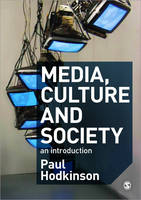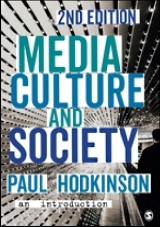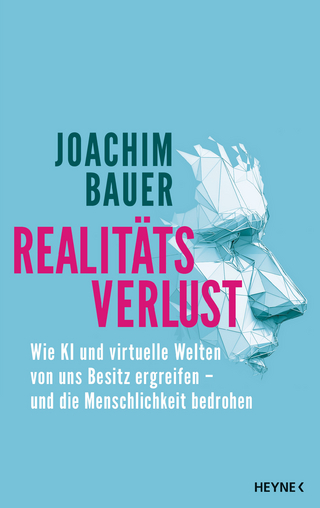
Media, Culture and Society
SAGE Publications Inc (Verlag)
978-1-4129-2053-7 (ISBN)
- Titel erscheint in neuer Auflage
- Artikel merken
′In his beautifully balanced, clear and broad-ranging account of a fast-changing field, Paul Hodkinson has successfully brought together myriad perspectives with which to critically analyse today′s media culture and media society′ - Sonia Livingstone, Professor of Media & communication, LSE
Clearly organized, systematic and combining a critical survey of the field with a finely judged assessment of cutting edge developments, this book provides a ′must have′ contribution to media and communication studies.
The text is organized into three distinctive parts, which fall neatly into research and teaching requirements: Elements of the Media (which covers media technologies, the organization of the media industry, media content and media users); Media, Power and Control (which addresses questions of the media and manipulation, the construction of news, public service broadcasting, censorship, commercialization); and Media, Identity and Culture (which covers issues of the media and ethnicity, gender, subcultures, audiences and fans).
The book is notable for:
• Logical and coherent organization
• Clarity of expression
• Use of relevant examples
• Fair minded criticism
• Zestful powers of analysis
It has all of the qualities to be adopted as core introductory text in the large and buoyant field of media and communication studies.
Paul Hodkinson is a sociologist whose work is focused upon youth cultures, online communications and on the relationships between media and cultural identities. He has conducted extensive research on goth subculture and is author of Goth. Identity, Style and Subculture (2002, Oxford: Berg). He is also co-editor of Youth Cultures: Scenes, Subcultures and Tribes (2007, London: Routledge). He is currently researching young people′s use of online communications - notably through social networking sites. He is based in the Department of Sociology at the University of Surrey. He joined the department of sociology in August 2003. He was previously Senior Lecturer in Media Studies at University College Northampton and prior to that, he studied at the University of Birmingham at undergraduate and postgraduate level.
1. Introduction
Media, Culture, Society
Starting Points: Shaping, Mirroring and Re-Presenting
The Communication Process
Transmitters, Receivers and Noise
′Who Says What...?′ and Other Questions
Linear and One-Dimensional
Elements of Media in Sociocultural Context
Media, Power and Control
Media, Identity and Culture
Making Connections
PART ONE: ELEMENTS OF MEDIA
2. Media Technologies
Introduction
Contrasting Medium Theories
McLuhan: The Medium Is the Message
Kill Your Television
Technological Determinism
Hot, Cool or Both?
Generalization and Reification
Technologies and Social Contexts
Capacities and Constraints
Into the Digital Age
Convergence
Interactivity
Mobility
The Internet: A Cure for Social Ills?
Conclusion: Technologies in Context
3. Media Industry
Introduction
Media Organizations
Commercial Ownership
Concentration of Ownership = Concentration of Ideas?
The Bottom Line: Sources of Revenue
Advertising Revenue
Direct Audience Payments
Payments between Media Companies
Maximizing Audiences
The Role of Sponsors
Governments and Regulation
Access Restrictions
Ownership Restrictions
Content Regulation
Deregulation
Supporting the Industry: Copyright
Conclusion: Economic Determinism?
4. Media Content
Introduction
Media Texts as Arrangements of Signs
Signs as Arbitrary?
Levels of Meaning
Signs as Relational
Uncovering Mythology
Limitations of Semiology
Narrative, Genre and Discourse Analysis
Narrative Analysis
Genre Analysis
Discourse Analysis
From Quality to Quantity: Content Analysis
′Systematic, Objective and Quantitative′
Categories and Coding
Population and Sample
Case Study: Gerbner and Television Violence
Limitations of Content Analysis
Conclusion: Putting Texts into Context
5. Media Users
Introduction
U S Empirical Traditions of Audience Research
Effects Research
Limited Effects and Two-Step Flow
Uses and Gratifications
Functionalist and Complacent?
Cultural Studies: Dominant and Oppositional Readings
Encoding, Decoding and Preferred Meanings
Social Context and Differential Readings
Audiences as Cultural Producers
Ethnographies of Audiences, Fans and Users
Conclusion: An Uncritical Celebration?
PART TWO: MEDIA, POWER AND CONTROL
6. Media as Manipulation? Marxism and Ideology
Introduction
Marxism and Ideology: Basics
The Culture Industry as Mass Deception
Unsupported Elitism?
Ideological Meanings
Beyond Marx′s Materialism
Case Study: Consumerist Myths
Political Economy and Ideology
Manufacturing Consent
Cultural Imperialism as Globalization of Ideology
Arguments and Criticisms
Political Economic versus Cultural Approaches
Complex Communication Flows and Consumer Resistance
Conclusion: Avoiding Easy Dismissals
7. The Construction of News
Introduction
Selection, Gatekeeping and Agenda-Setting
News Values
Case Study: September 11th 2001
Constructing Stories
Differences between News Providers
Medium
Style and Market Position
Political Stance
Similarities: Back to Bias and Ideology?
Class Bias
Institutional Bias
Infotainment and Depoliticization
Conclusion: Bad News?
8. Public Service or Personal Entertainment? Controlling Media Orientation
Introduction
Public Service Broadcasting (PSB)
Reith and the BBC
Differing PSB Arrangements
Developing PSB Principles
Enabling or Imposing?
Censorship: Preventing Harm and Offence
Avoiding Majority (and Minority) Offence
Pornography
Violence
Preventing Harm or Inhibiting Freedom?
Commercial Competition and Consumer Choice
Neo-Liberal Approaches
US Broadcasting: A Free Market Model
A Toaster with Pictures: The Decline of Regulation
Conclusion: A Rosy Commercial Future?
9. Decline of the National Public: Commercialization, Fragmentation and Globalization
Introduction
Media and the Public Sphere
Habermas′ Public Sphere
Media and Public Engagement
Nation as ′Imagined Community′
Decline of the Public Sphere
From Facilitators to Shapers
Commercially Driven Content
Digital Dilution of the Nation
Fragmentation
Globalization
The Internet: Interactive but Fragmented
Conclusion: National Public - Good Riddance?
PART THREE: MEDIA, IDENTITY AND CULTURE
10. Media, Ethnicity and Diaspora
Introduction
Racism and Exclusion
Representation
Under-Representation
Stereotypical Representations
The Reproduction of Subordination
Promoting ′Positive′ Images
Reversing Stereotypes of Passivity
Successful, Well Adjusted, Integrated
The Burden of Representation
New Ethnicities and Diaspora
New Ethnicities
Diaspora
Representing Diaspora
Audience Segregation
Newspapers, Video and Global Bollywood
Digital Specialization
Online Diaspora
Conclusion: Empowerment or Ghettoization?
11. Media, Gender and Sexuality
Introduction
Constructions of Femininity
Female Marginalization
The Male Gaze
Patriarchal Romance and Domesticity
Post-Feminist Independence?
The Enduring Gaze
Elitist Critics?
Empowering Possibilities
Reading the Romance
Subversive Pleasures?
From Consumers to Producers
Remaining Critical
Media and Masculinities
Masculinity or Masculinities?
Lads′ Mags and Contradictory Representations
Beyond Heterosexuality
Conclusion: A Balanced Approach
12. Media Communities: Subcultures, Fans and Identity Groups
Introduction
Media versus Community
Homogenization and Atomization
Resisting Mass Culture (and Media): Youth Subcultures
Moral Panic and Mass Media Stigmatization
Targeting Community
Local Media
Niche Magazines and Consumer Groupings
Niche Digital Media
DIY Media and Internet Communication
Fanzines
Online Micro-Communication
Virtual Community
Communities or Individuals?
Conclusion: All about Definitions
13. Saturation, Fluidity and Loss of Meaning
Introduction
Saturation as Loss of Meaning
Consumerism: Expansion and Speed-up
Information Overload
Media = Reality
From Truth, to Ideology, to Simulacra
Celebrity Culture as Hyperreal
Identity: Fragmentation and Fluidity
Recycling and Pastiche
The Internet as Virtual Playground
Simulated Identity?
Internet as Extension of Everyday Life
Case Study: Social Networking Sites
Conclusion: Saturated but Real?
Glossary
| Erscheint lt. Verlag | 15.10.2010 |
|---|---|
| Verlagsort | Thousand Oaks |
| Sprache | englisch |
| Maße | 170 x 242 mm |
| Gewicht | 560 g |
| Themenwelt | Sozialwissenschaften ► Kommunikation / Medien ► Medienwissenschaft |
| ISBN-10 | 1-4129-2053-1 / 1412920531 |
| ISBN-13 | 978-1-4129-2053-7 / 9781412920537 |
| Zustand | Neuware |
| Informationen gemäß Produktsicherheitsverordnung (GPSR) | |
| Haben Sie eine Frage zum Produkt? |
aus dem Bereich



